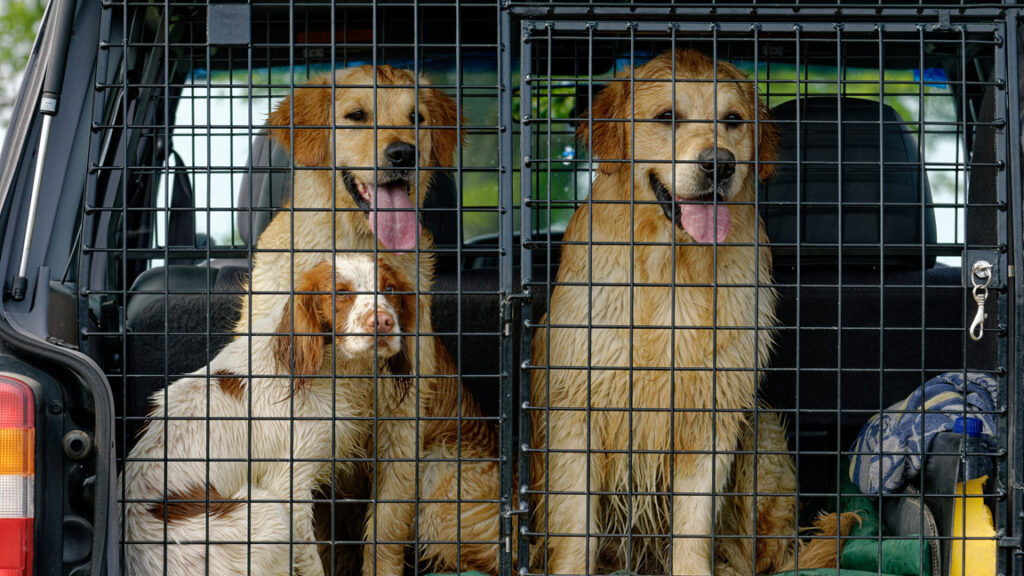
Do you suspect or hope that your dog is pregnant? Whatever your situation, it is possible at a certain stage of a pregnancy to know if a dog is expecting babies. What are the signs to observe that indicate pregnancy? How to differentiate a pregnancy from a nervous pregnancy? How long does gestation last in dogs? What diagnosis should be made with the veterinarian? What to do next and how to support the dog towards her role as future mother or towards an abortion? Our answers in this file.
Is my dog expecting babies? What are the signs of pregnancy?
When a female dog is pregnant, she may exhibit several symptoms. While some are typical of pregnancy, they may be more or less visible and some female dogs will show other signs that are far from systematic. Finally, as in pregnant women, each dog experiences her pregnancy in her own way and is likely to present symptoms specific to it, sometimes making the pregnancy difficult to identify, especially when the owner was not present at the mating.
In female dogs, the fluctuation of the hormones estrogen, progesterone, prolactin and relaxin will directly influence the symptoms and their intensity. In any case, the signs of pregnancy are mainly visible by observing the animal's udders and its behavior.
The udders of the pregnant dog
As with women, the dog prepares very early to become a mother. Around 4 to 5 weeks of gestation, her udders prepare the milk flow to feed the young as soon as they are born. Thus, they take a darker shade And they are getting bigger due to the natural increase in blood flow.
Subsequently, in certain female dogs, we can observe a few drops of colostrumpearl at the level of the udders. This transparent liquid can also turn white. In all cases, we do not press or touch the bitch's udders so as not to stimulate their lactation too soon before the puppies are born, at the risk of causing painful engorgement, in particular.
We can also observe transparent secretions flow from the female dog's vulva. If they are normal, any other coloring should alert you and lead you to consult a veterinarian.
There weight gain, for its part, does not occur immediately. It's only around 45 to 50 daysthat the future mother has a more rounded belly.
The behavior of the pregnant dog
The pregnant dog usually changes behavior within the first few weeks. As with human women, the dog can have an increased appetite or, conversely, no longer have much desire to eat.
Some future canine mothers appear somewhat depressed, less dynamic, less energetic, less lively. Some female dogs tend to seek tranquility and isolate themselves, while others will, on the contrary, follow their human everywhere and act like a cat in search of the slightest caress.
A few days before giving birth, the dog prepares for the birth of her babies. It is said that she nests. In fact, she makes a small nest to settle in with her offspring, with the cushions, blankets, throws, fabrics and comforters that she can glean here and there from around the house.
Pregnancy or nervous pregnancy: how to know?
It is possible for a female dog to show many signs of pregnancy. Her udders may be red and swollen, she may have milk coming in, be clingy or distant, start to nest and yet… she is not pregnant. We speak of nervous pregnancy, phantom pregnancy, pseudo-gestation or even pseudocyesis.
This phenomenon, which women can also experience, is not an illness, but a disorder which has no real consequences for the dog's health. However, milk surges can be difficult for the animal and the change in behavior can sometimes be difficult to bear for those around them, especially if the phenomenon is repeated.
It is often difficult to know whether a dog is truly pregnant or not. Only an ultrasound carried out by a veterinarian allows you to ensure this. If there is no puppy, the practitioner confirms the nervous pregnancy. It is then necessary to block the flow of milk with inhibitors prescribed by the practitioner. In addition, if the female dog is not intended for breeding, it is better to have her sterilized to avoid recurrences.
How is pregnancy diagnosed in dogs?
Diagnosis of gestation
If you suspect pregnancy in your dog or if it is detected during a consultation, it is, in any case, necessary to carry out an official diagnosis at the veterinarian.
From 21 days after the projection, it is possible to carry out a ultrasound which makes it possible to determine the date of the term and to count the number of little ones which make up the litter, with more or less accuracy.
From 25 daysthe veterinarian can hear the heartbeat puppies using an electrocardiogram or stethoscope, but without being able to distinguish them from each other. This is a good way to check that the pregnancy is in progress without an ultrasound, initially.
From 30 daysthe practitioner can carry out a blood test to know the levels of different hormones, including relaxin, which allows a more reliable diagnosis to be made. It usually only takes a few minutes to obtain the result after analysis.
The due date
You must know that gestation in dogs lasts between 57 days and 72 days according to the departure date taken into account for the calculation.
- Based on the date of the last ovulation, it takes 63 days (62 to 64 days more precisely). This is the most reliable method, but requires frequent consultations during the dog's heat and blood tests to determine hormone levels.
- If we base ourselves on the date of the mating, it takes 57 to 70 days. In fact, the delay is longer because the male dog's sperm can survive up to 7 days in the female dog's uterus, awaiting ovulation. So it directly depends on when mating occurs during the cycle. You should know that the longer the sperm wait, the fewer the number of puppies will be, because many of them will be eliminated before fertilization.
If these two dates are unknown, it is necessary to practice an ultrasound or an x-ray to determine the due date. In any case, determining this date is crucial to better support the mother-to-be and to act in case of need, particularly for urgent intervention (if the gestation lasts too long, for example).
Palpation of puppies
Although it is tempting to touch your dog's belly to detect the small puppies it contains, it is not recommended to carry out a palpation without the presence of a veterinarian, because the slightest clumsiness can be dangerous for the little ones.
In any case, the unborn litter cannot be felt by touch only from 21 to 28 days. Depending on the breed, the puppies are, at this point, the size of a cherry or the size of a golf ball. The veterinarian can feel, through palpation, the thickening of the dog's uterus and the small amniotic sacs (or fetal bulbs) that contain the pups.
However, palpation is not enough to reliably determine the number of puppies in the litter. The ultrasound will be the most telling.
My dog is pregnant: what should I do?
Once the pregnancy diagnosis is confirmed by the veterinarian, what happens next depends on your decision. It all depends on whether you want to keep the babies or end your dog's pregnancy.
If you want to keep the puppies
If you want your dog to carry her pregnancy to term and keep the puppies, you will need to organize the various pregnancy monitoring appointments with your veterinarian. But that's not all ! Here is what you will need to do to support the mother-to-be.
- Pregnancy monitoring : the veterinarian must regularly examine your dog to ensure that the pregnancy is going well. Around 45e day, he carries out an ultrasound to determine the exact number of puppies to be born and identify any possible risks of complications.
- Accompanying the dog : you need to help your dog in her pregnancy by providing her with the most comfortable space and the most calm and serene atmosphere possible. We avoid sources of stress and maintain walks while avoiding activities that are too brutal and outings that are too sporty.
- The dog's diet : get advice from your veterinarian, but your dog's diet must be adapted to her condition. If she is healthy, well-nourished, not overweight or underweight, maintain her usual diet at first. Otherwise, give him puppy kibble and break up his meals. Thereafter, gradually increase the quantities as he gains weight, starting over the last five weeks.
- Nesting : you can help the future mother set up her nest in the last days of her gestation by providing her with comfortable, soft and clean blankets, throws and cushions.
- Finding adoptive families : If you don't keep all the future babies yourself, start looking around for adoptive families. This will allow you to select those who seem the most loving and the most motivated to welcome a little companion in the best possible conditions. Do not hesitate to talk to your veterinarian. However, as a reminder, it is prohibited to give or sell a dog before the age of 8 weeks, or ideally 10 weeks! The puppy must in fact be weaned to leave its mother.
If you wish to terminate the gestation
If you do not want puppies, you must plan a medical abortion which will end your dog's pregnancy. Depending on the stage of gestation, the veterinarian will be able to implement different solutions. However, be aware that it is generally impossible to abort a dog after 45 days of gestation.
- If pregnancy is detected early, it will be easier to abort the female dog and she will suffer fewer consequences on her health.
- If the gestation is advanced, the procedure will be more cumbersome, even close to giving birth. It will be much more trying for the dog.
If you do not want your dog to have babies one day, it is best to consider sterilization. Your veterinarian will probably suggest this for you. This operation will prevent recurrences and generally preserves the health of the females. The earlier it is performed – in other words the fewer periods of heat the dog has had before the operation – the more it limits the risks of cancer and infections of the reproductive system and the mammary chain.




